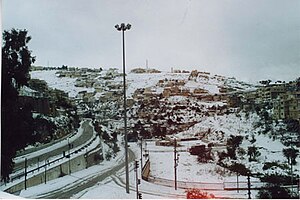Al-Salt
|
Al-Salt السلط Saltus |
||
|---|---|---|
| City | ||
 |
||
|
||
| Nickname(s): Saltus (Ancient Greek) | ||
| Location in Jordan | ||
| Coordinates: 32°02′N 35°44′E / 32.033°N 35.733°E | ||
| Country |
|
|
| Governorate | Balqa Governorate | |
| Founded | 300 B.C. | |
| Municipality | 1887 | |
| Government | ||
| • Type | Municipality | |
| • Mayor | Khalid Khashman | |
| Area | ||
| • City | 48 km2 (19 sq mi) | |
| • Metro | 79 km2 (31 sq mi) | |
| Elevation | 820 m (2,690 ft) | |
| Population (2011) | ||
| • City | 88,900 | |
| • Density | 1,479/km2 (3,830/sq mi) | |
| Time zone | UTC+2 (UTC+2) | |
| • Summer (DST) | UTC+3 (UTC+3) | |
| Area code(s) | +(962)5 | |
| Website | http://www.salt.gov.jo/ar | |
Al-Salt (Arabic: السلط Al-Salt — pronounced Es-Sult or Es-Salt) is an ancient agricultural town and administrative centre in west-central Jordan. It is on the old main highway leading from Amman to Jerusalem. Situated in the Balqa highland, about 790–1,100 metres above sea level, the town is built in the crook of three hills, close to the Jordan Valley. One of the three hills, Jabal al-Qal'a, is the site of a 13th-century ruined fortress. It is the capital of the Balqa Governorate.
The Greater Salt Municipality has about 97,000 inhabitants (2006) of which 65% are Muslim and 35% Christians.
It is not known when the city was first inhabited, but it is believed that it was built by the Macedonian army during the reign of Alexander the Great. The town was known as Saltus in Byzantine times and was the seat of a bishopric. At this time, the town was considered to be the principal settlement on the East Bank of the Jordan River. The settlement was destroyed by the Mongols and then rebuilt during the reign of the Mamluk sultan Baibars (1260–1277) and became a regional capital once more during the time of the Ottoman Empire. In the early 1830s, Salt was again attacked, this time being blown up during a raid by the Egyptian viceroy Ibrahim Pasha in his campaigns against the Ottomans in Palestine.
Salt's heyday was in the late 19th century when traders arrived from Nablus to expand their trading network eastwards beyond the Jordan River. As a result of the influx of newcomers this period saw the rapid expansion of Salt from a simple village into a town with many architecturally elegant buildings, many built in the Nablusi style from the attractive honey-coloured local stone. A large number of buildings from this era survive as of 2009[update].
...
Wikipedia


